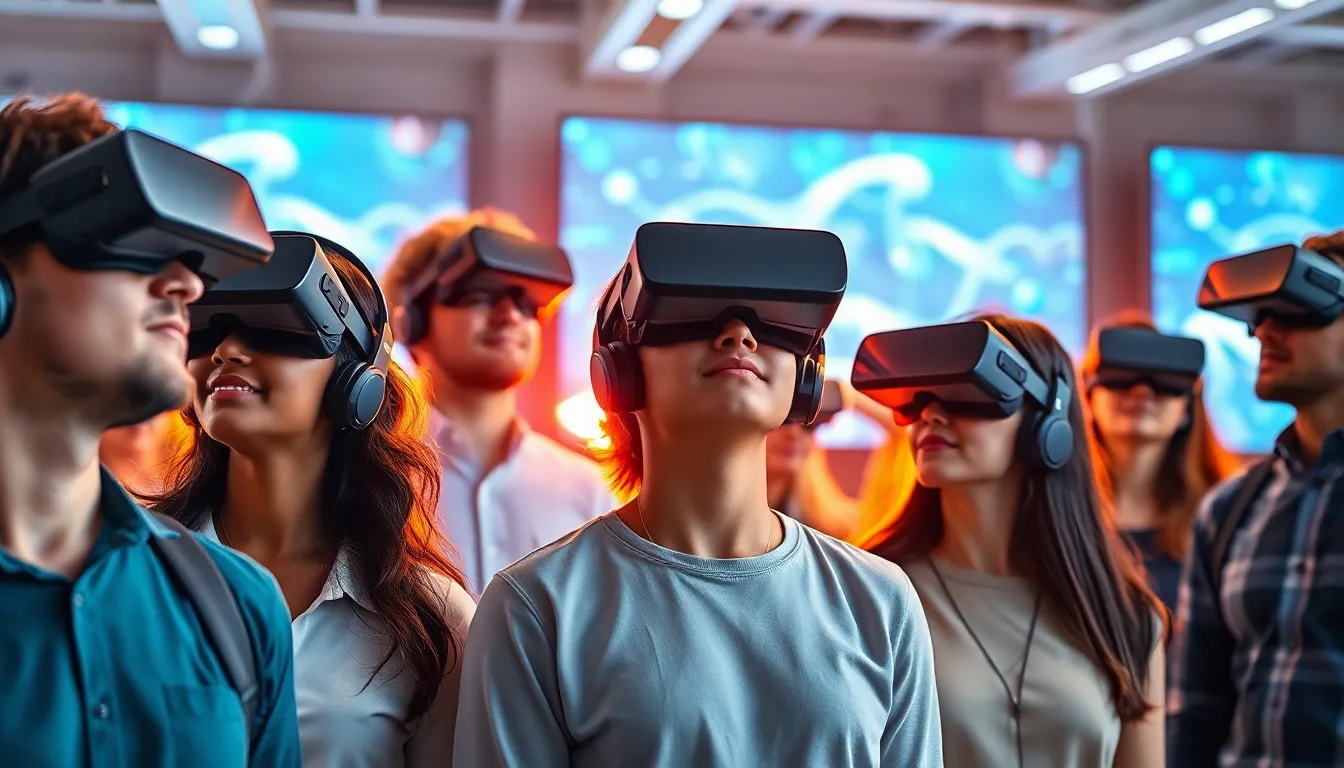In a world where reality feels a bit too… well, real, digital realities are stepping in to save the day. Imagine a place where you can explore ancient ruins without leaving your couch or attend a concert in your pajamas. Sounds dreamy, right? With advancements in virtual and augmented reality, the line between the digital and physical worlds is blurrier than ever, and it’s changing how we interact with everything around us.
Table of Contents
ToggleOverview of Digital Realities
Digital realities encompass technologies like virtual reality (VR) and augmented reality (AR), which transform user experiences. Users explore immersive environments through VR, engaging with entirely digital worlds. AR overlays digital elements onto the real world, enhancing everyday experiences with relevant information.
These innovations reshape entertainment, education, healthcare, and retail sectors significantly. In entertainment, platforms such as PlayStation VR and Oculus Quest deliver rich gaming experiences. Education benefits from applications that simulate complex systems, allowing students to visualize concepts in 3D. Healthcare leverages digital realities for training and simulations, improving surgical skills and patient interactions.
Statistics indicate that the global AR and VR market exceeded $18 billion in 2020, with projections reaching over $200 billion by 2025. This rapid growth highlights increasing adoption across various demographics. Many companies invest in these technologies to provide unique experiences and maintain competitive advantages.
Digital realities invite users to attend virtual events, such as concerts and conferences, from anywhere in the world. Notable platforms like Spatial and VRChat facilitate social interactions in virtual spaces. These environments foster connections among users from diverse backgrounds and locations.
Challenges remain within the digital realities space, including accessibility, content creation, and health concerns. Some users experience motion sickness in VR applications, while others may find high-quality content scarce. Addressing these issues is crucial for wider acceptance and success.
The interplay between digital realities and emerging technologies, such as artificial intelligence and 5G, enhances overall experiences. Innovations build more responsive environments, offering seamless integration of digital and physical realms. As advancements continue, expectations around digital realities will evolve, creating further opportunities for engagement and interaction.
Types of Digital Realities

Digital realities include various immersive technologies, primarily virtual reality, augmented reality, and mixed reality. Each type offers unique experiences that significantly reshape user interactions.
Virtual Reality
Virtual reality creates immersive experiences through digital environments. Users wearing VR headsets can explore simulated worlds as if they were physically present. This technology finds uses in gaming, training, and therapy, allowing users to confront fears or practice skills. The global VR market value reached nearly $18 billion in 2020, with projections indicating growth to over $200 billion by 2025. Developers continually create engaging content to enhance user experiences.
Augmented Reality
Augmented reality overlays digital elements onto the real world. AR technology enhances everyday experiences with enriched visuals and information. Users access AR through smartphones and smart glasses, experiencing interactive content that integrates seamlessly with their surroundings. Applications span various sectors, including retail, where AR allows customers to visualize products before purchase. With a significant increase in AR adoption, the demand for innovative AR applications grows rapidly.
Mixed Reality
Mixed reality combines elements of both virtual and augmented realities. This technology enables users to interact with both digital and physical objects in real time. Users can manipulate holograms while simultaneously interacting with their environments, creating a cohesive experience. Industries leverage mixed reality for design collaboration, remote assistance, and immersive training simulations. As mixed reality continues to evolve, its applications expand further, presenting new possibilities for user engagement.
Applications of Digital Realities
Digital realities offer transformative potentials across various sectors, revolutionizing user experiences and interactions.
Gaming and Entertainment
Gaming ranks among the most significant applications of digital realities. Virtual reality immerses players in expansive worlds, allowing for unprecedented levels of engagement and interactivity. Popular titles like Beat Saber and Half-Life: Alyx exemplify this trend. Augmented reality also enhances entertainment experiences, enabling users to interact with digital content in their physical environments, as seen with Pokémon GO. The gaming industry continues to thrive, with global revenues projected to reach $200 billion by 2025, driven largely by advances in digital realities.
Education and Training
Education undergoes a substantial transformation through digital realities. Virtual classrooms facilitate global learning experiences, bridging distances and enhancing student engagement. Schools and institutions use VR for immersive simulations, providing realistic scenarios for subjects like science and history. Furthermore, augmented reality enriches lessons by overlaying digital information onto physical objects, making learning more interactive. Training programs in industries such as aviation and medicine use mixed reality for simulations, allowing professionals to practice in safe environments, ultimately improving skill retention.
Healthcare
Healthcare leverages digital realities to enhance patient care and medical training. Virtual reality aids in pain management, providing distraction during procedures and therapy sessions. Medical professionals use VR simulations for training, mastering complex surgical procedures in risk-free environments. Augmented reality assists surgeons during operations by overlaying critical information onto patients’ anatomy, improving accuracy and outcomes. As the healthcare sector embraces these technologies, patient education and rehabilitation programs also benefit, fostering more effective treatment plans and patient involvement.
Challenges and Considerations
Digital realities present unique challenges that require careful attention. Technological limitations affect user experiences and the widespread adoption of digital realities.
Technological Limitations
Latency in digital realities can disrupt user immersion. Delays in feedback can lead to frustration and disengagement. Device compatibility often causes access issues, with some users unable to utilize the latest technologies. Limited content creation tools hinder developers from producing quality experiences, leading to uneven content availability. High costs associated with advanced VR and AR equipment may restrict access for many potential users. These limitations impede the potential growth of the market, which is projected to exceed $200 billion by 2025.
Ethical Concerns
Concerns regarding user privacy play a significant role in digital realities. Data collection often occurs in immersive experiences, raising questions about how developers use that information. The potential for addiction also poses a risk, with users becoming overly engrossed in virtual environments. Psychological impacts, including social isolation, can arise from excessive use of digital realities. Moreover, accessibility issues can create inequalities in experiences, leaving marginalized groups behind. Ethical considerations need thorough examination to ensure equitable and responsible development in the evolving landscape.
Future of Digital Realities
Growth in digital realities, including virtual reality (VR), augmented reality (AR), and mixed reality (MR), significantly shapes various sectors. The global VR market reached nearly $18 billion in 2020 and is projected to exceed $200 billion by 2025. These figures highlight the increasing consumer interest and investment in these technologies.
Entertainment and gaming remain at the forefront of these advancements. Immersive experiences offered by VR, seen in popular titles like Beat Saber and Half-Life: Alyx, attract millions of players. Industry revenue estimates suggest that the gaming market is expected to reach $200 billion by 2025, driven by innovations in digital realities.
Education is another sector experiencing transformation through these technologies. Virtual classrooms provide global learning opportunities, while augmented reality enhances lessons by overlaying information on real objects. Mixed reality is particularly beneficial for training in industries such as aviation and medicine, allowing students to practice in controlled environments.
Healthcare also benefits from digital realities. Virtual reality supports pain management and offers realistic simulations for training medical professionals. Augmented reality aids surgeons, providing essential information during operations. Patient education and rehabilitation programs now incorporate these technologies, improving treatment outcomes and involvement.
Challenges persist in the integration of digital realities. Technological limitations, including compatibility issues and costs, can hinder user experiences. Ethical concerns about privacy, addiction, and social effects necessitate responsible development. Addressing these challenges ensures equitable access while supporting anticipated growth in the digital realities market, projected to surpass $200 billion by 2025.
Emerging technologies like artificial intelligence and 5G further enhance user experiences, fostering greater engagement across platforms. Digital realities continue evolving, promising endless possibilities for future interactions and experiences.
Digital realities are undeniably reshaping how individuals engage with the world. As technologies like VR and AR continue to evolve, they offer innovative ways to connect, learn, and experience life beyond traditional boundaries. The rapid growth in these sectors signals a future filled with enhanced interactions and opportunities across various industries.
While challenges remain, the potential for digital realities to improve sectors such as education and healthcare is immense. By addressing technological and ethical concerns, stakeholders can ensure these advancements benefit everyone. The journey into digital realities is just beginning, and its impact promises to be profound and far-reaching.

